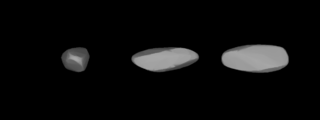Related Research Articles

816 Juliana is a minor planet orbiting the Sun. It measures 59.85k in diameter. It was discovered on 8 February 1916 by Max Wolf at the Landessternwarte Heidelberg-Königstuhl Observatory in Heidelberg, Germany.
818 Kapteynia is a minor planet orbiting the Sun. This asteroid is named for the Dutch astronomer Jacobus Kapteyn.

819 Barnardiana is a minor planet orbiting the Sun, discovered on March 3, 1916, by the German astronomer Max Wolf in Heidelberg.
820 Adriana, provisional designation 1916 ZB, is an exceptionally dark asteroid from the outer region of the asteroid belt, about 59 kilometers in diameter. It was discovered by German astronomer Max Wolf at Heidelberg Observatory in southern Germany, on 30 March 1916.
823 Sisigambis is an asteroid belonging to the Flora family in the Main Belt. Its diameter is about 17 km and it has an albedo of 0.179. Its rotation period is unknown but appears to be greater than at least 12 hours. The asteroid is named after Sisygambis, the mother of Darius III of Persia.
827 Wolfiana, provisional designation 1916 ZW, is a Florian asteroid from the inner regions of the asteroid belt, approximately 8 kilometers in diameter. It was discovered at Vienna Observatory on 29 August 1916, by Austrian astronomer Johann Palisa, who named it after German astronomer Max Wolf. The assumed stony asteroid has a rotation period of 4.0654 hours.
831 Stateira is an asteroid belonging to the Baptistina family in the Main Belt named after Stateira, wife of Artaxerexes II.
833 Monica is a minor planet orbiting the Sun. Measurements of the lightcurve made in 2010 give a rotation period of 12.09 ± 0.01 hours. It has a diameter of 21.2 km.

837 Schwarzschilda, provisional designation 1916 AG, is a low-eccentric, well-observed asteroid from the asteroid belt, orbiting the Sun with a period of 3.48 years at a distance of 2.21–2.39 AU. It was discovered by German astronomer Max Wolf at Heidelberg Observatory on 23 September 1916.
839 Valborg is a mid-sized S-type Eunomian asteroid. Its diameter is about 20 km, its albedo of 0.353 is very high for an asteroid. Its rotation period is 10.366 hours.
841 Arabella is an asteroid belonging to the Flora family in the Main Belt. Its rotation period is 3.39 hours. It is named after the title character from Richard Strauss' opera Arabella.
843 Nicolaia is a main-belt asteroid discovered by Danish astronomer H. Thiele on 30 September 1916. It was a lost asteroid for 65 years before being rediscovered by Astronomisches Rechen-Institut at Heidelberg in 1981. The asteroid is orbiting the Sun with a period of 3.44 years.
846 Lipperta is a Themistian asteroid.
851 Zeissia is an S-type asteroid background asteroid from the inner region of the asteroid belt. Its diameter is about 12 km and it has an albedo of 0.2646 . Its rotation period is 9.34 hours.

852 Wladilena is a Phocaea asteroid from the inner region of the asteroid belt. It is named after the Russian Communist leader Vladimir Lenin.
853 Nansenia is a minor planet orbiting the Sun. It is named after the Norwegian polar explorer and Nobel Peace Prize laureate Fridtjof Nansen.
854 Frostia is a main-belt asteroid orbiting the Sun. It was discovered in 1916 by Sergei Ivanovich Belyavsky from Simeiz Observatory in Crimea and is named after Edwin Brant Frost, an American astronomer. This asteroid measures approximately 8.4 km (5.2 mi) in diameter.

857 Glasenappia is a minor planet orbiting the Sun. It was named after Russian astronomer Sergey Glazenap, who was often referred to as "S. de Glasenapp" in pre-Revolution publications.
824 Anastasia is a main belt asteroid orbiting the Sun. It is approximately 34.14 km in diameter. It was discovered on March 25, 1916, by Grigory Neujmin at Simeiz Observatory in Russian Empire. It is named in memory of Anastasia Semenoff, an acquaintance of the discoverer.
829 Academia is a minor planet orbiting the Sun. The asteroid is roughly 44 km in diameter and has a low albedo. Photometric measurements of the asteroid made in 2005 at the Palmer Divide Observatory showed a light curve with a period of 7.891 ± 0.005 hours and a brightness variation of 0.44 ± 0.02 in magnitude.
References
- 1 2 3 4 "828 Lindemannia (1916 ZX)". JPL Small-Body Database . NASA/Jet Propulsion Laboratory . Retrieved 4 May 2016.